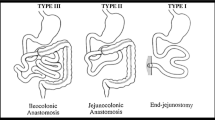Summary
Background
The resection of large segments of small intestine can cause short bowel syndrome.
Methods
A patient is described who underwent extensive bowel resection 15 years after vagotomy and antrectomy for peptic ulcer disease.
Results p The patient did not develop short bowel syndrome.
Conclusions
Acid reducing operations might have their place amongst other surgical procedures which have been proposed for treating refractory short bowel syndrome.
Zusammenfassung
Grundlagen
Nach Resektion großer Teile des Dünndarms entwickelt sich das Kurzdarmsyndrom.
Methodik p Ein Patient mit ausgedehnter Dünndarmresektion 25 Jahre nach Vagotomie und Antrektomie wegen Ulcus pepticum, wird beschrieben.
Ergebnisse
Der Patient entwickelte kein Kurzdarmsyndrom.
Schlu\folgerungen
Säurereduzierende Operationen haben neben anderen chirurgischen Maßnahmen ihren Stellenwert zur wirkungsvollen Beeinflussung des Kurzdarmsyndroms.
Similar content being viewed by others
References
Thompson JS: Surgical considerations in the short bowel syndrome. Surg Gynec Obstet 1993;176:89.
Albo RJ, Angotti D, Sorensen D: Value of selective and truncal vagotomy in massive bowel resection. Am J Surg 1974;128:234.
Burrington JD: Surgery after massive bowel resection. Am J Surg 1971;121:213.
Thompson JS, Harty RJ, Saigh JA: Morphological and nutritional responses to intestinal patching following intestinal resection. Surgery 1988;103:79.
Wolff SA, Telander RL, Go VLW, et al: Effect of proximal gastre vagotomy and truncal vagotomy and pyloroplasty on gastric functions and growth in puppies after massive small bowel resection. J Pediatr Surg 1979;14:441.
Craig TV, Stewart WR: Massive bowel resection in a patient with a 75 percent gastrectomy. Surgery 1960;48:678.
Shelton EL Jr, Blaine MD: Massive small bowel resection in postgastrectomy patients: report of two cases. Tex Med 1954;59:96.
Townsend CM Jr, Thompson JC: Small intestine, in Schwartz SI (ed): Principles of Surgery, Vol 1. 5th ed. New York: McGraw-Hill, 1989, pp 1216.
Clayton BE, Cotton DA: A study of malabsorption after resection of the entire jejunum and the proximal half of the ileum. Gut 1961;2:18.
Opie LH, Hunt BG, Finlay JM: Massive small bowel resection with malabsorption and negative magnesium balance. Gastroenterology 1964;47:415.
Brolin RE: Colon interposition for extreme short bowel syndrome: A case report. Surgery 1986;100:576.
Author information
Authors and Affiliations
Rights and permissions
About this article
Cite this article
Calik, A., Kucuktulu, U., Bilgin, Y. et al. Do previous acid reducing procedures protect patients from short bowel syndrome?—A case report. Acta Chir Austriaca 27, 223–225 (1995). https://doi.org/10.1007/BF02616531
Issue Date:
DOI: https://doi.org/10.1007/BF02616531




